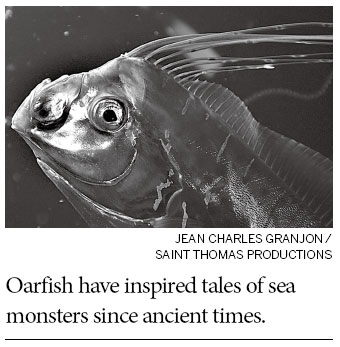A rare look at a little-known big fish
Updated: 2013-11-17 07:13
By Douglas Quenqua(The New York Times)
|
|||||||
It was a big day for marine biologists: On October 13, the body of a 5.5-meter oarfish was dragged from the water onto Santa Catalina Island off the California coast, presenting a rare opportunity for local scientists to study one of the world's most elusive and awe-inspiring big fish.
Five days later, another oarfish washed up 80 kilometers away, this one four meters long, with ovaries full of eggs.
Pairs of oarfish have appeared within days of each other before. But the twin discoveries nevertheless sent a wave of excitement through a scientific community more used to reading about oarfish than handling them.

"These are unpredictable fish," said Milton Love, a research biologist at the Marine Science Institute of the University of California, Santa Barbara. "And it's hard to study unpredictable fish."
Oarfish, which are long and eel-like in appearance, can grow to stupendous lengths - though long-ago rumors of 17-meter specimens are probably exaggerated - and have inspired tales of sea monsters since ancient times.
They are "virtually never caught in nets or by hooks, and they've only been observed underwater a handful of times," Dr. Love said.
The fish were dissected and divvied up among a few research institutions.
Early observations revealed that the second fish was apparently ready to spawn. "There were probably hundreds of thousands of eggs in those ovaries," said H. J. Walker, the marine biologist at the Scripps Institution of Oceanography in California who extracted the eggs. Its stomach was nearly empty, supporting the theory that a strong current had carried the pair away from their preferred environment.
Their species, Regalecus russelii, is most populous in the Western Pacific.
The male was missing some of the posterior part of its body. Tyson Roberts, an ichthyologist with the Smithsonian Tropical Research Institute in Panama, has long hypothesized that oarfish can jettison sections of their bodies below the abdomen, much the way lizards can shed their tails.
While most experts refer to oarfish as deep-sea creatures, Dr. Roberts says they are not.
"Mostly they spend their time quite near the surface, suspended vertically with their heads up, just passively floating," he said.
The facts may become clearer as researchers study the eyes of the new specimens, possibly learning whether they are designed to see in the low light of the deep ocean.
With long bodies, toothless jaws and giant red dorsal fins that protrude from their heads, oarfish are often mistaken for monsters. "Most biologists will tell you it probably is the species responsible for the sea serpent legend," Dr. Walker said.
An ancient Japanese myth holds that washed-up oarfish are a sign of an impending earthquake. But Dr. Love said: "If something about tectonic movement is killing these fish, why aren't the other fish in the environment doing the same thing?"
The New York Times
(China Daily 11/17/2013 page12)